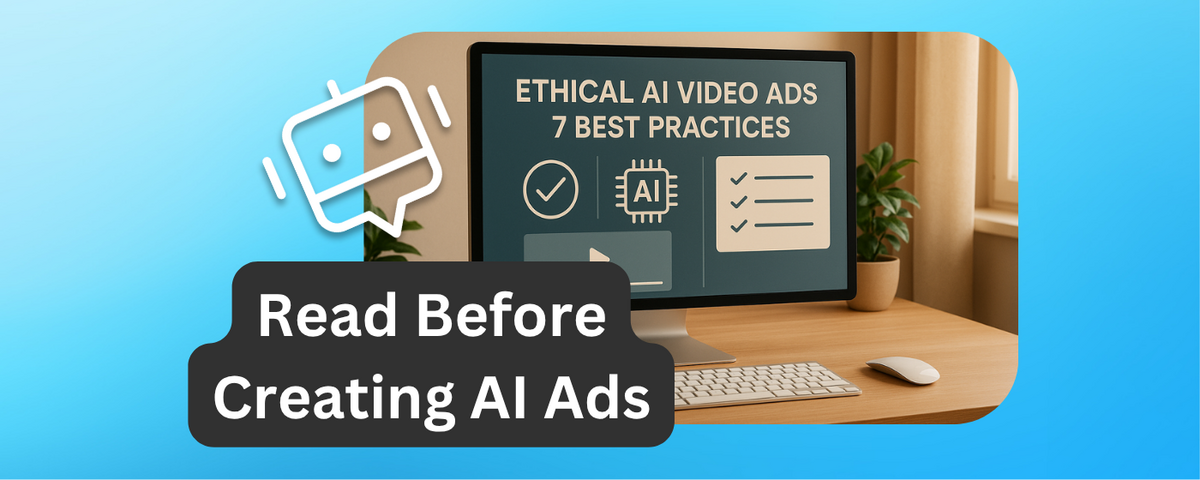AI is transforming video advertising, but using it responsibly is critical.
To build trust, ensure privacy, and avoid legal risks, follow these seven practices:
- Disclose AI Use: Clearly label AI-generated content to maintain transparency and meet regulations.
- Get User Consent: Explain data collection clearly and comply with laws like GDPR and CCPA.
- Prevent Bias: Use diverse training data and audit AI outputs to avoid stereotypes or unfair outcomes.
- Maintain Human Oversight: Keep humans involved for quality control and accountability.
- Avoid Misleading Content: Ensure all claims, visuals, and messages are truthful and accurate.
- Secure Data: Use encryption, limit data collection, and comply with privacy laws.
- Design for Accessibility: Make content usable for everyone, including those with disabilities.
Ep. 42: Navigating AI Ethics in Advertising - AdTech Heroes
1. Be Clear About AI-Generated Content
Being upfront about AI-generated content isn’t just ethical - it’s becoming a necessity. When viewers can’t tell if they’re watching something crafted by humans or AI, it can erode trust and even lead to legal troubles.
The solution? Clear disclosure. Label any use of AI in your content creation process. This can be as simple as adding watermarks, text overlays, or a note in the video description. The key is to make it obvious and easy to understand. By doing so, you not only meet emerging standards but also set the tone for transparency.
Compliance with Ethical Standards
Regulations are tightening. Agencies like the FTC are cracking down on undisclosed AI use, and platforms like YouTube now offer tools for labeling AI-generated content. To stay ahead, make sure your practices align with these evolving rules.
Keep in mind that different platforms may have their own requirements for AI disclosure. Staying compliant means staying informed about the specific guidelines for each channel where your ads appear.
Building Audience Trust
Transparency isn’t just about following rules - it’s also about strengthening your relationship with your audience. When brands openly share that they’re using AI, many viewers see it as a sign of innovation, not deception. The real damage happens when AI use is hidden and later uncovered - this can hurt your brand’s reputation and weaken trust.
Being upfront also helps set the right expectations. When audiences know what to expect, their experience improves, and they’re more likely to engage positively with your content.
For video editors using tools like DriveEditor, adding simple disclosures during the editing process can make compliance easier. Whether it’s a quick text overlay or a brief mention, these small steps can save time and avoid hassle later.
Embrace transparency as part of your brand’s identity. Done well, disclosing AI use isn’t just about compliance - it’s a way to show your commitment to honest and open communication.
2. Get User Consent and Protect Data Privacy
Once you've transparently disclosed the use of AI-generated content, safeguarding user data becomes equally important. AI systems thrive on large amounts of data, much of which comes directly from users - often without them fully understanding how their information is collected or utilized. Prioritizing proper consent and robust data protection measures is essential.
The real challenge? Making user consent meaningful rather than just a legal formality. People need to clearly understand what data is being collected, how AI will use it, and what potential benefits or risks are involved. This requires moving away from those endless terms of service that no one reads and instead offering simple, straightforward explanations. On top of that, staying compliant with key privacy regulations is a must.
Compliance with Ethical Standards
Privacy laws like GDPR in Europe and CCPA in California set the bar high when it comes to data collection and AI usage. Both require explicit, active consent from users. Under GDPR, for example, consent must be freely given, specific, informed, and unambiguous - no more sneaky pre-checked boxes. Users need to actively agree, fully aware of what they're signing up for. Meanwhile, CCPA mandates that businesses disclose the personal information they collect, explain how it’s used, and give users the option to opt out of data sales to third parties.
These regulations don’t just protect users - they also guide businesses in building systems that respect privacy and transparency.
Building Trust Through Transparency
Trust is fragile, especially when it comes to data privacy. When users feel their information is secure and handled responsibly, they’re more likely to engage with your content and provide valuable feedback. Instead of burying data collection details in fine print, be upfront. Explain why you need their data, how AI will use it to enhance their experience, and the steps you take to protect their privacy.
A great way to show transparency is by offering privacy dashboards. These tools allow users to see exactly what data you’ve collected and how it’s being used. While this level of openness might seem risky, it actually builds trust by proving you’ve got nothing to hide.
Prioritizing Data Privacy and Security
Protecting user data requires a combination of strong technical and organizational measures. Encryption should safeguard data both during transmission and while it’s stored. Implement access controls so that only authorized personnel can view sensitive information, and conduct regular security audits to catch any vulnerabilities.
Equally important is data minimization - only collect what’s absolutely necessary for your AI systems to function. For instance, if you don’t need a user’s precise location, don’t ask for it. Skip demographic details if they’re not critical for your objectives. Less data collected means fewer risks.
Adopt data retention policies that automatically delete unnecessary information. Not only does this reduce security risks, but it also demonstrates a proactive commitment to user privacy.
For video editors using tools like DriveEditor, it’s crucial to understand how user data flows through the editing process. If you’re incorporating AI-generated elements or automated features, ensure users know what data these tools access and how it’s protected.
Lastly, conduct privacy impact assessments to identify potential risks before they escalate. These evaluations should examine how data moves through your AI systems, assess the strength of your security measures, and test whether your consent processes are genuinely user-friendly.
3. Prevent Algorithmic Bias
AI systems rely on data to learn, but if that data carries historical biases or lacks diversity, the algorithms can unintentionally replicate unfair outcomes. In video advertising, this might result in campaigns that favor certain demographics or reinforce harmful stereotypes. Tackling algorithmic bias isn’t just an ethical responsibility - it’s also key to creating campaigns that resonate with a broader audience.
Bias can creep in at various stages, such as data collection, model training, content creation, or ad distribution. Because it often operates subtly, it’s crucial to adopt systematic methods to detect and address it. This effort goes hand-in-hand with broader goals of transparency and responsible data use.
Compliance with Ethical Standards
To ensure fairness, organizations need to align their use of AI in video advertising with ethical principles and evolving regulatory guidelines. Regular audits of algorithms and proactive adjustments are essential steps to mitigate bias before it becomes an issue.
Audience Trust and Satisfaction
Addressing bias is a natural extension of prioritizing ethical transparency and data privacy. When AI systems produce biased content, it can harm brand reputation and alienate audiences. Ads that overlook or misrepresent specific communities erode trust - not just in the technology but also in the brands behind it. This loss of trust can directly hurt engagement and revenue.
Balanced representation plays a critical role here. Biased portrayals can weaken inclusivity and limit audience connection. To foster trust, introduce feedback tools that let users flag biased content, helping brands stay accountable and responsive.
Inclusivity and Accessibility
Creating inclusive AI-driven video ads means embracing the full range of human diversity - spanning age, ethnicity, body types, abilities, and cultural backgrounds. Start by ensuring your training data reflects this diversity, and conduct regular audits of AI-generated outputs to confirm they meet your inclusion goals.
Also, think about accessibility. For instance, verify that automated captions are accurate across various accents and speaking styles. This ensures that all users, regardless of how they speak, can engage with your content effectively.
Video editors should keep an eye on AI-assisted features to make sure they don’t favor specific aesthetic preferences or demographic groups. If automated editing leans toward narrow visual styles or representations, step in and make manual adjustments. Testing AI-generated content with diverse focus groups can help identify and resolve these issues.
Make bias testing a routine part of your workflow to reinforce ethical AI practices. By running scenarios that involve different demographic groups, you can spot patterns in how content is selected or ads are targeted. Document these insights to refine your algorithms continually, ensuring your AI-powered video ads are fair and equitable for all audiences.
4. Maintain Human Control and Responsibility
AI can process data quickly and efficiently, but it falls short when it comes to human judgment, especially in complex scenarios. That’s where people come in - bringing fairness, transparency, and trust into the mix. Striking the right balance between AI’s speed and human accountability is key.
To keep things on track, human oversight should be part of every stage. This means reviewing AI outputs before going live, monitoring performance metrics, and making critical decisions about targeting. If an AI system flags an issue or produces unexpected results, it’s up to humans to step in and take charge.
Accountability is non-negotiable. Assign specific team members to oversee different aspects of AI-driven video ad campaigns, from content approval to tracking performance. Clear roles ensure that responsibility for decisions doesn’t get lost in the shuffle.
Compliance with Ethical Standards
Human involvement also plays a big role in meeting legal and ethical expectations. As regulations around AI continue to evolve, many jurisdictions now require human oversight in automated decision-making systems, particularly when consumer experiences are at stake.
Documentation is your safety net. Keep detailed records of the human review process, key points where humans intervened, and the reasoning behind significant campaign decisions. These records not only help with audits but also improve your oversight methods over time.
It’s also vital to train your team on both the technical and ethical aspects of AI. This ensures that your video advertising practices align with ethical standards while maintaining accountability.
Audience Trust and Satisfaction
When consumers know humans are involved in the AI process, they’re more likely to trust the content. In fact, being transparent about human oversight can set your brand apart, showing audiences that you take responsibility for your automated systems.
If AI makes a mistake or generates inappropriate content, having a human team ready to act can prevent major damage to your brand’s reputation. To enable this, you’ll need monitoring systems that alert human operators to potential issues before they get out of hand.
Feedback channels are another critical piece. Allowing audiences to report concerns directly to human reviewers - not just automated systems - builds trust. Plus, it provides valuable insights to fine-tune your AI systems and reinforces your commitment to ethical advertising.
Data Privacy and Security
Human oversight isn’t just for content - it’s essential for protecting personal data, too. AI systems should always handle data in line with privacy laws and company policies, and humans must verify that these standards are being met.
Sensitive data operations need human approval. This includes decisions about what data to collect, how long to keep it, and when to delete it. While AI might focus on optimizing metrics, humans must weigh privacy implications carefully.
Regular data audits are a must. These reviews should examine what data your AI systems are collecting and how it’s being used for targeting decisions. This ensures your video advertising stays ethical and compliant with privacy standards.
Inclusivity and Accessibility
AI can miss important nuances when it comes to accessibility and cultural relevance - areas where human judgment is essential. For instance, human reviewers can spot errors in automated captions, ensuring they accurately reflect different accents and speaking styles. They can also confirm that visual elements are accessible to users with diverse abilities.
Cultural sensitivity requires a human touch. While AI might detect certain patterns, it takes human insight to determine whether content could be offensive or exclude specific communities.
To streamline this process, build checkpoints into your workflow for humans to review AI-generated content. For example, tools like DriveEditor can make it easier to adjust content directly within your workflow. This keeps the process efficient while ensuring your video advertising meets ethical and inclusive standards without unnecessary delays.
sbb-itb-0482353
5. Stay Honest and Avoid Misleading Content
When it comes to AI video advertising, honesty is non-negotiable. Misleading claims or exaggerated promises can erode trust and damage your brand's reputation. AI systems, while advanced, can sometimes generate content that strays from reality. It's up to you to ensure that every piece of content reflects the truth and sets realistic expectations for your audience.
Always use clear, data-backed messaging that accurately represents your product or service. Avoid letting AI make promises about results or features that don’t exist. Double-check before-and-after comparisons, testimonials, and performance metrics to ensure their accuracy.
Visual honesty is just as important as verbal transparency. While some visual enhancements are standard in advertising, they must still reflect the actual product. Over-the-top or deceptive edits not only risk losing customer trust but could also lead to legal consequences. By committing to both visual and verbal accuracy, you'll not only meet regulatory requirements but also build a foundation of trust with your audience.
Compliance with Ethical Standards
The Federal Trade Commission (FTC) holds advertisers accountable for all claims made in their ads, regardless of whether the content was created by a human or AI. This means you must verify all AI-generated content with solid, documented data sources. If your advertising practices come under scrutiny, you'll need to demonstrate that you maintained proper oversight and fact-checking processes.
As AI-generated content becomes more common, industry standards are evolving to address these new challenges. Organizations like the Interactive Advertising Bureau (IAB) are working on guidelines that emphasize truthfulness and accountability. Staying informed about these developments not only protects your brand but also shows your commitment to ethical advertising practices.
Audience Trust and Satisfaction
Strict adherence to honesty doesn’t just keep you on the right side of the law - it also helps you earn and maintain your audience’s trust. In digital advertising, trust is fragile. If your AI-generated video ads overpromise or misrepresent, customers will notice - and they’ll likely share their disappointment on social media or review sites.
Instead of relying on flashy, exaggerated claims, focus on promoting the real benefits of your product or service. Authentic messaging might not generate a flood of clicks right away, but it builds stronger, long-term relationships with customers who appreciate your honesty.
Recent studies show that consumers are becoming increasingly skeptical of advertising, particularly as they learn more about AI’s role in content creation. By being upfront about what your product delivers, you can stand out in a crowded market full of inflated promises.
Inclusivity and Accessibility
Honesty in advertising also means representing your audience fairly and inclusively. AI-generated content can sometimes unintentionally exclude certain groups or create unrealistic portrayals of who benefits from your product or service.
To avoid this, ensure that your content reflects diverse and realistic representations of your audience. If your AI-generated videos feature people, make sure they align with the demographics of your customer base and don’t perpetuate stereotypes or exclude communities. This isn’t just about meeting social expectations - it’s about showing real people who genuinely benefit from your offerings.
Pay special attention to accessibility claims. If your AI suggests that your product is accessible to users with disabilities, verify that these claims are accurate. Misleading accessibility promises not only harm vulnerable populations but could also expose your company to legal risks under the Americans with Disabilities Act.
To streamline this process, use tools that integrate seamlessly into your workflow. For example, DriveEditor allows you to make quick adjustments to AI-generated content, ensuring accuracy and inclusivity without disrupting your production schedule. This way, you can maintain efficiency while upholding your commitment to honest advertising.
6. Handle Data Securely
Protecting data is a cornerstone of ethical AI video advertising. When you collect viewer data to power your AI systems, you're taking on a serious responsibility. Think of it as safeguarding something as critical as your company’s trade secrets. Mishandling this data can lead to breaches, regulatory fines, and long-term damage to your brand’s reputation.
AI video advertising systems handle a massive amount of user data - everything from viewing habits and click patterns to demographic details and device information. This data is the fuel that powers algorithms, deciding which ads to show and when. But with great data comes great responsibility. The more you collect, the higher the stakes for ensuring its security.
Data Privacy and Security
To keep data safe, encryption is your first line of defense. Use AES-256 encryption to protect user data both in transit and at rest. Limit access through role-based permissions and enforce multi-factor authentication for added security. Regularly audit who has access to sensitive data and why.
Adopt a data minimization strategy. By collecting only the data you absolutely need, you reduce both risk and responsibility. Less data means fewer vulnerabilities.
Schedule quarterly security audits and make them mandatory after major system updates. Performing regular penetration tests can help uncover weaknesses before bad actors exploit them.
Compliance with Ethical Standards
Technical safeguards are just part of the equation. You also need to comply with privacy laws like the California Consumer Privacy Act (CCPA), which grants users rights such as knowing what data you collect, requesting its deletion, and opting out of data sales. Your AI systems must be designed to honor these requests swiftly and completely.
If you’re targeting users in the European Union, GDPR compliance is non-negotiable, regardless of where your company is based. This requires strict standards for data handling and user consent.
Leverage industry tools like the IAB Tech Lab's Transparency and Consent Framework to standardize how you manage user consent. These frameworks not only simplify compliance but also signal your commitment to ethical data practices.
Keep detailed records of your data-related processes - what you collect, how it’s used, where it’s stored, and who has access. Clear documentation is often required by regulators and demonstrates accountability.
Audience Trust and Satisfaction
Today’s users are increasingly aware of how their data is collected and used, especially in AI-driven advertising. Building trust starts with transparency. Be upfront about what data you collect and how it enhances their ad experience. Instead of burying this information in lengthy privacy policies, consider creating user-friendly, visual summaries that highlight the benefits of sharing data.
Empower users by giving them control over their data. Offer intuitive settings where they can adjust what information they share, the types of ads they see, and how their data is used to train AI systems. When users feel in control, they’re more likely to engage positively with your ads.
Handle data requests and concerns with urgency and professionalism. Whether users want to know what data you have, request deletions, or ask questions, a prompt response can actually strengthen their trust in your brand. Even when users choose to limit data sharing, a positive interaction can leave a lasting impression.
Be prepared for the worst-case scenario. If a data breach occurs, notify affected users immediately. Clearly explain what happened, what data was involved, and what steps you’re taking to prevent future incidents. Transparency in these situations can preserve trust far better than trying to downplay the issue.
For editing AI-generated video content securely, tools like DriveEditor can be a game-changer. These tools let you make necessary adjustments without exposing sensitive user information to additional third-party platforms. This streamlined approach reduces the number of systems handling your data, lowering security risks while ensuring your advertising content stays ethical and compliant.
7. Create Content for All Users
Making AI video ads inclusive isn't just the right thing to do - it's also smart. When your content speaks to everyone, regardless of their background, abilities, or circumstances, you naturally widen your audience and deepen connections with viewers. By focusing on accessibility, you’re not only aligning with ethical standards but also creating better experiences for all. Let’s explore how to ensure your AI video ads are usable by everyone.
Inclusivity and Accessibility
Not everyone experiences content the same way. Some viewers depend on screen readers, others need captions, and many benefit from high-contrast visuals or slower-paced scenes. Your AI systems should be equipped to address these diverse needs when generating and targeting video content.
- Visual accessibility: Go beyond just using color to convey information - add text labels, icons, or patterns. Ensure text is easy to read by maintaining a contrast ratio of at least 4.5:1 for regular text and 3:1 for larger text.
- Audio considerations: Always include accurate captions and audio descriptions for essential visual elements. Train your AI to flag moments where visual information is critical so that additional audio support can be added.
- Cognitive accessibility: Keep your messages straightforward. Avoid overly complex language or rapid scene changes that might overwhelm certain viewers.
- Motor accessibility: Design interactive elements that are large enough to click or tap easily, and ensure they remain accessible for users with limited mobility by allowing enough time for interaction.
Compliance with Ethical Standards
Accessibility isn’t just about doing what’s right - it’s also about meeting legal requirements. The Americans with Disabilities Act (ADA) outlines clear expectations for digital accessibility. While enforcement in advertising is still evolving, taking proactive steps now can protect your brand from potential legal challenges.
The Web Content Accessibility Guidelines (WCAG) 2.1 Level AA serve as the gold standard for digital accessibility. Program your AI systems to automatically check for issues like color contrast, proper heading structures, and the size and spacing of interactive elements. This way, accessibility is built into your workflow, reducing the need for fixes after content is created.
If your ads are featured on government websites or target federal agencies, you may also need to meet Section 508 compliance standards. These align closely with WCAG but have additional requirements specific to federal content. Ensure your AI systems can recognize when these standards apply and adjust content accordingly.
Audience Trust and Satisfaction
When viewers feel represented and can easily engage with your content, they’re more likely to trust and connect with your brand. Inclusive design sends a clear message: your brand values everyone.
To achieve this, train your algorithms on diverse datasets that reflect people of varying ages, ethnicities, body types, and abilities. Regularly audit your AI’s output to avoid reinforcing stereotypes. If your content consistently features certain demographics while excluding others, it’s time to expand your training data and fine-tune your algorithms.
Cultural awareness is another key factor. Different communities have unique preferences for communication styles, aesthetics, and references. Equip your AI to consider these nuances when targeting specific audiences, and review content regularly to avoid cultural misunderstandings.
Feedback is essential for improvement. Create easy ways for users to report accessibility issues or share suggestions. Pay attention to comments on social media and customer service channels about your ad accessibility, and use that input to refine your AI systems.
When making adjustments to AI-generated video content, tools like DriveEditor can help you quickly tweak captions, contrast, and timing without slowing down your workflow.
Finally, user testing with diverse groups is invaluable. Include individuals with disabilities in your testing process, and fairly compensate them for their time and insights. Their feedback can help you identify gaps that automated tools might miss and improve both your content and AI training processes.
Comparison Table
Implementing ethical AI video ads requires a thoughtful mix of strategies. Here's a quick comparison of key practices to guide your approach:
| Practice/Tool | Primary Use | Advantages | Disadvantages | Best For |
|---|---|---|---|---|
| AI Content Disclosure | Transparency compliance | Builds trust, meets legal standards, and is easy to implement | May reduce click-through rates initially; requires consistency | All AI-generated video content |
| Explicit User Consent | Data privacy protection | Ensures legal compliance and fosters trust through clear boundaries | Can lower conversion rates | Campaigns collecting personal data |
| Diverse Training Data | Bias prevention | Reduces stereotypes, appeals to a broader audience, and enhances accuracy | Costly and time-consuming | AI model development and training |
| Human Oversight Systems | Quality control | Identifies AI errors, upholds brand standards, and ensures accountability | Increases costs and slows down production | High-stakes campaigns and sensitive content |
| Fact-Checking Protocols | Content accuracy | Prevents misinformation, protects brand reputation, and builds credibility | Lengthens production timelines | Educational and informational video ads |
| Data Encryption | Security compliance | Safeguards user data, meets regulatory requirements, and prevents breaches | Technically complex | All data collection and storage |
| DriveEditor | Accessibility enhancement | Quick text additions and contrast adjustments for $29/month | Limited to basic editing features | Social media marketers needing fast edits |
| WCAG 2.1 Compliance | Accessibility standards | Broadens audience reach, improves user experience, and provides legal protection | Requires technical expertise | All public-facing video content |
To meet ethical standards effectively, consider combining approaches. For example, use diverse training data to minimize bias, pair automated systems with human oversight for quality control, and rely on tools like DriveEditor for quick accessibility adjustments.
Budget is another important factor. While basic measures like content labeling are low-cost and quick to implement, more intensive efforts like bias testing and human review require greater investment. Tools such as DriveEditor, with its $29/month unlimited plan, offer a cost-effective way to make rapid accessibility improvements.
Scalability also plays a big role as video ad production ramps up. Automated systems are great for routine compliance checks, while human oversight is better suited for high-stakes or sensitive campaigns. By balancing automation with human input, you can maintain both efficiency and ethical standards.
Conclusion
Ethical AI video advertising isn’t just about following rules - it’s about building trust with your audience through transparency and responsibility. By focusing on the seven key practices - disclosure, consent, bias prevention, human oversight, honesty, secure data handling, and inclusivity - you can create marketing strategies that protect both your users and your brand.
Each of these practices plays a crucial role. For example, maintaining human oversight ensures quality control, while honest messaging avoids misleading claims that could harm your reputation. Securely handling data safeguards sensitive information, and designing accessible content ensures your message reaches as many people as possible.
These principles work best when applied together, not in isolation. A combination of automated tools and human review creates a stronger ethical framework. Tools like DriveEditor can make accessibility updates more efficient, helping you meet these standards seamlessly.
FAQs
How can businesses ensure their AI-generated video ads comply with privacy regulations like GDPR and CCPA?
To meet privacy regulations like GDPR and CCPA, businesses need to focus on honest and responsible data practices. This means getting clear user consent, providing straightforward opt-out options, and putting in place strong security measures to protect personal information.
On top of that, companies can use AI tools to streamline consent management and make sure all data usage is fully explained. Prioritizing transparency and respecting user privacy doesn't just help businesses stay compliant - it also strengthens trust with their customers.
How can I reduce algorithmic bias in AI-powered video ads?
To reduce bias in AI-driven video advertising, it’s crucial to start with diverse and inclusive training datasets. This helps ensure the AI performs fairly across various demographic groups. Another important step is to regularly audit your AI systems. These audits can uncover hidden biases in the system's outputs, allowing you to address them proactively.
You should also focus on building algorithms with fairness constraints baked into their design. This means incorporating tools and processes that can detect and adjust biased results automatically.
Equally important is promoting transparency and accountability in your AI practices. Clearly document how your systems function and involve team members from varied backgrounds in both development and review stages. Together, these strategies can lead to more ethical and effective video ad campaigns.
Why is human oversight essential in AI-powered video ad campaigns, and how can it be effectively applied?
Human involvement plays a key role in AI-driven video ad campaigns, helping to uphold ethical standards, minimize mistakes, and protect brand reputation. While AI can streamline processes, it’s not immune to producing biased or unsuitable outcomes. That’s where human judgment steps in - to identify and address these issues while making thoughtful decisions.
To ensure oversight is effective, bring in experts to carefully review AI-generated content. They can verify that outputs align with ethical principles and your brand’s guidelines. Additionally, regular audits of input data and campaign performance help confirm that your ads meet user expectations and adhere to compliance standards.




